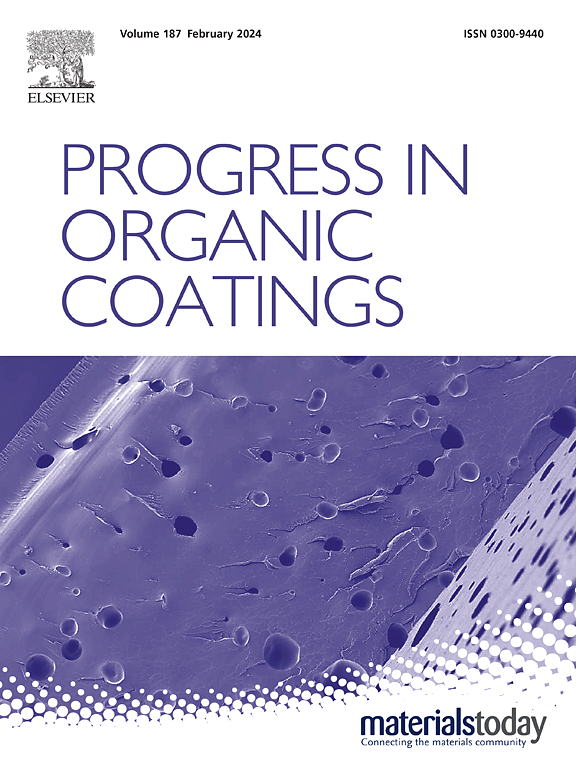Liquid metal@graphene oxide nanoparticles toughened polybenzoxazine and its high-performance coating applications
IF 7.3
2区 材料科学
Q1 CHEMISTRY, APPLIED
引用次数: 0
Abstract
Polybenzoxazine has attracted widespread attention as a new thermosetting resin. However, its inherent relative brittleness limits the application. In this paper, a synergistic toughening strategy utilizing liquid metal (LM) and graphene oxide (GO) self-assembled composite particles (LM@GO) is proposed to optimize the structural properties of the benzoxazine system. By controlling the ratio of LM@GO, the liquid metal component effectively inhibits crack propagation by energy absorption during deformation, while the combined effect of LM and GO enhances energy dissipation, leading to a significant improvement in mechanical properties. The experimental results showed that the impact toughness and flexural strength of the composites with 3 % LM@GO addition were 208 % and 194 % of those of the pure resin. Additionally, the thermal stability of the composite is significantly enhanced, with the char yield at 800 °C increasing from 26.8 % to 45.4 %. The composite coating exhibits outstanding comprehensive performance, including a hardness of 6H, adhesion of 5B, corrosion resistance improved by two orders of magnitude compared with the pure resin (with RC increasing from 1.4 × 104 Ω to 3.4 × 106 Ω), and its thermal conductivity is 121 % of pure resin (0.23 W/(m·K)). This study provides another insight into the toughening of polybenzoxazines and expands their potential applications in fields such as electronic heat dissipation and anticorrosion coatings.
液体metal@graphene纳米氧化物增韧聚苯并恶嗪及其高性能涂层应用
聚苯并恶嗪作为一种新型热固性树脂受到了广泛的关注。然而,其固有的相对脆性限制了其应用。本文提出了一种利用液态金属(LM)和氧化石墨烯(GO)自组装复合粒子(LM@GO)的协同增韧策略,以优化苯并恶嗪体系的结构性能。液态金属组分通过控制LM@GO的比值,在变形过程中通过吸收能量有效抑制裂纹扩展,而LM和GO的共同作用增强了能量耗散,从而显著改善了材料的力学性能。实验结果表明,添加3% LM@GO的复合材料的冲击韧性和抗弯强度分别是纯树脂的208%和194%。此外,复合材料的热稳定性显著增强,800℃时的炭产率从26.8%提高到45.4%。复合涂层综合性能优异,硬度达到6H,附着力达到5B,耐腐蚀性能比纯树脂提高了2个数量级(RC从1.4 × 104 Ω提高到3.4 × 106 Ω),导热系数为纯树脂的121% (0.23 W/(m·K))。该研究为聚苯并恶嗪的增韧提供了另一种见解,并扩大了其在电子散热和防腐涂料等领域的潜在应用。
本文章由计算机程序翻译,如有差异,请以英文原文为准。
求助全文
约1分钟内获得全文
求助全文
来源期刊

Progress in Organic Coatings
工程技术-材料科学:膜
CiteScore
11.40
自引率
15.20%
发文量
577
审稿时长
48 days
期刊介绍:
The aim of this international journal is to analyse and publicise the progress and current state of knowledge in the field of organic coatings and related materials. The Editors and the Editorial Board members will solicit both review and research papers from academic and industrial scientists who are actively engaged in research and development or, in the case of review papers, have extensive experience in the subject to be reviewed. Unsolicited manuscripts will be accepted if they meet the journal''s requirements. The journal publishes papers dealing with such subjects as:
• Chemical, physical and technological properties of organic coatings and related materials
• Problems and methods of preparation, manufacture and application of these materials
• Performance, testing and analysis.
 求助内容:
求助内容: 应助结果提醒方式:
应助结果提醒方式:


